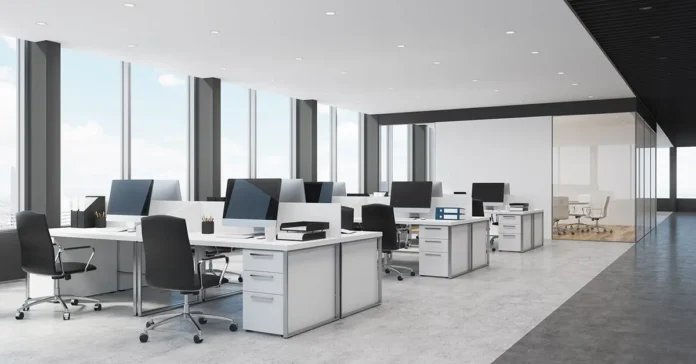In the fast-paced world of business, discovering the ideal office space is more than a quest for square footage. The importance of finding the right office space cannot be overstated. It forms the bedrock of a conducive work environment, efficiency, and collaboration within a team. This journey begins with understanding the diverse factors that shape office space needs. From the size of your team to the intricacies of your workflow, each element plays a crucial role in determining the perfect workspace.
In this article, we unravel the complexities and shedding light on considerations often overlooked. Whether you’re a budding entrepreneur or a seasoned business owner, the insights provided will guide you in navigating the sea of options, helping you discover the ideal office space that aligns with your unique needs and fosters a culture of innovation and success. Welcome to the exploration of your ideal workspace!
Office Space – Business Requirements
Begin by determining the size of your team – the heartbeat of your operation. Consider not just the present team size but also potential growth in the future. This foresight ensures that your chosen space accommodates your team comfortably, fostering a conducive work environment.
Next, evaluate your workflow and collaboration needs. Understand the dynamics of how your team interacts, whether it’s through collaborative projects or individual tasks. This insight helps in designing a workspace that enhances productivity and teamwork.
Furthermore, consider future growth and flexibility in your assessment. A workspace that accommodates scalability ensures you won’t outgrow your office prematurely. Flexibility allows your office space to evolve with your business needs, providing room for innovation and adaptation.
Analyzing Work Environment
First identify the nature of your work—whether it’s focused and individual, or collaborative and team-oriented. This insight aids in determining the balance between private and open office spaces. Understanding the need for private workstations ensures that employees have dedicated spaces for concentration and focused efforts. Also, the importance of collaborative areas cultivates teamwork and idea exchange..
Consider the tools and devices crucial to your daily tasks, from computers and printers to specialized equipment. This step guarantees that your office space is not only aesthetically pleasing but also functionally optimized.
Budget Considerations for an Ideal Office Space
It’s important to estimate your budget constraints realistically. This involves not only looking at your current financial standing but also forecasting for potential growth. Once the financial landscape is clear, the journey moves to exploring cost-effective solutions. This doesn’t mean compromising on quality; rather, it’s about being savvy with choices.
Consider alternative office layouts, shared spaces, or flexible lease options that align with your financial goals. While dream office spaces may boast luxury, it’s essential to discern which amenities are non-negotiable for your team’s productivity and well-being. Striking this balance ensures that your office space not only accommodates financial constraints but also provides a conducive environment for your team.
Location and Accessibility
Selecting the right location for your office is like finding the heart of your business. Start by evaluating preferred office locations, keeping in mind the pulse of your industry and the vibe that aligns with your company culture. Consider the proximity to clients and partners to make sure an ease of accessibility. A conveniently located office not only reduces commute stress but also enhances overall job satisfaction.
Whether it’s a bustling city center or a quieter suburban area, the chosen location should resonate with your team’s needs. Remember, the right location not only fosters business growth but also creates an environment where productivity thrives.
Regulatory and Compliance Factors for an Office Space
Zoning regulations, marked as our first checkpoint, are the guidelines that dictate how a particular area can be utilized. By comprehending these rules, you ensure that your chosen office space aligns with its designated purpose.
Moving onto our second consideration, compliance with building codes acts as the foundation of a secure and functional workspace. These codes are outlining the structural and safety requirements necessary for a legally compliant establishment.
Our third point, meeting safety and accessibility standards, by prioritizing safety not only safeguards your team but also enhances the overall atmosphere. By embracing accessibility standards, you ensure that everyone, regardless of physical ability, can navigate and contribute to your workspace seamlessly.
Final Words
Remember that the right office space caters to your team’s size, workflow, and future aspirations. The significance of finding this balance cannot be overstated, as the workplace directly influences employee productivity and satisfaction. It’s not just about physical space; it’s about creating an environment that fosters collaboration, innovation, and overall well-being.
A thoughtfully chosen space reflects your company’s identity, positively impacting employee morale and attracting talent. Think of your office space not just as a place for work but as a canvas where your business vision comes to life. By approaching office space planning strategically, you pave the way for a workspace that not only meets your needs today but also evolves with your success in the future.
FAQs
A1: Evaluate the number of employees, required workstations, and additional space for meetings or collaborative areas to gauge the ideal office size.
A2: Consider factors like accessibility, proximity to clients or partners, and the overall business environment when selecting the location for your office.
A3: Assess the potential employee growth, meeting space needs, and any additional departments or functionalities your business may require in the future.
A4: A well-planned layout can optimize space usage, ensuring efficient workflows and accommodating various work zones within the office.
A5: The nature of your business, such as whether it’s client-facing, collaborative, or requires specialized equipment, significantly impacts the necessary office space.
A6: Yes, co-working spaces provide flexibility and cost-effectiveness for businesses with dynamic or unpredictable space requirements.
A7: While regulations vary, a common guideline is allocating around 100-150 square feet per employee, considering the industry and specific work requirements.
A8: Find the right balance by prioritizing essential space requirements, considering budget constraints, and exploring cost-effective office space solutions.
A9: A collaborative or open-office culture may require more communal areas, while a more traditional or private culture may necessitate additional enclosed workspaces.
A10: Yes, real estate professionals and office space planning services can provide expertise in assessing your needs to find perfect space.







